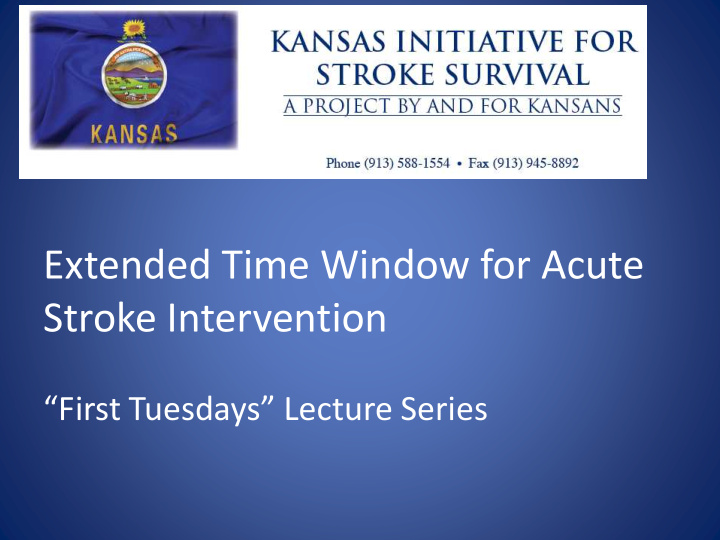



Update from education committee • Train the trainer — content reviewed from Extended Time Window for Acute Stroke Intervention “First Tuesdays” Lecture Series
Introduction and Goal of “First Tuesdays” • Sabreena Slavin MD – Vascular Neurologist and Neurohospitalist at KU School of Medicine • Didactic lecture series as part of the Kansas Initiative for Stroke Survival • Updates in Practice and FAQ’s on Acute Stroke Care • 20 minute didactic, 10 minutes for questions/discussion.
Review of Acute Stroke Interventions • IV alteplase (tPA) for all patients who have disabling symptoms of acute stroke • Mechanical thrombectomy: only for large vessel occlusions (LVO). Only hospitals with capabilities (eg: comprehensive stroke center) can perform thrombectomy. – A higher NIHSS (10 or more) can be indicative of a large vessel occlusion. – Diagnosed with CTA head/neck
Extended Time Window • Time limit for IV tPA: 4.5 hours from last known normal. This is unchanged. • Time limit for mechanical thrombectomy: Previously was up to 6 hours from last known normal. Now can take up to 24 hours from last known normal. This is a new change in recommendation based on recent studies.
From the 2018 Guidelines for Management of Acute Ischemic Stroke • New recommendations, class I, level A: – “In selected patients with AIS within 6 to 24 hours of last known normal who have LVO in the anterior circulation, obtaining CTP, DW-MRI, or MRI perfusion is recommended to aid in patient selection for mechanical thrombectomy , but only when imaging and other eligibility criteria from RCTs showing benefit are being strictly applied in selecting patients for mechanical thrombectomy .” Based on DAWN and DEFUSE 3 trials Powers et al, Stroke, 2018
Perfusion Imaging • CT perfusion and MR perfusion imaging is used to find a mismatch between ischemic core (area already damaged) and ischemic penumbra (area at risk of damage). • Measures of core: cerebral blood volume, cerebral blood flow • Measures of penumbra: mean transit time (ratio cerebral blood flow/cerebral blood volume), time to peak, time to drain, and T max (measures of contrast arrival time to tissue).
Radiopedia, https://radiopaedia.org/articles/ct-perfusion-in-ischaemic-stroke
RAPID software to analyze core and penumbra: iSchemaView RAPID: www.irapid.com
DAWN Trial • Enrolled patients 6 to 24 hours after last known well with prestroke mRS 0-1 and with ICA or M1 occlusion. • Imaging inclusion criteria: clinical-core mismatch • If greater than 80, needed NIHSS ≥ 10 and core volume ≤ 20 mL • If less than 80 and NIHSS ≥ 10, needed core volume ≤ 30 mL • If less than 80 and NIHSS ≥ 20, needed core volume 31 to 50 mL. • Max core volume should be 50 mL. • Randomized 1:1 to thrombectomy vs standard medical care. Nogueira et al, NEJM, 2018
Results of DAWN Trial Nogueira et al, NEJM, 2018
DEFUSE 3 Trial • Enrolled patients 6 to 16 hours post last known well with prestroke mRS 0-2 and with ICA or M1 occlusion. Max age 85, NIHSS ≥ 6. This included a broader population than DAWN. • Imaging inclusion criteria: perfusion-core mismatch. • Core < 70 mL, mismatch ratio > 1.8 and mismatch volume ≥ 15 mL • Randomized 1:1 to thrombectomy vs standard medical care. Albers et al, NEJM, 2018
DEFUSE 3 Trial Results Albers et al, NEJM, 2018
How this translates • EMS: – Use prehospital triage scales for LVO, including FAST- ED, for all patients with suspected stroke within 24 hours. Communicate with ED prior to arrival. – If suspecting an LVO, stay near ED to facilitate further transport if necessary for fast door-out time. • Community ED: – If higher NIHSS, please obtain ASPECTS from CT scan. Consider CTA/CTP imaging if resource available. – Call endovascular-capable center early if suspecting LVO to facilitate transport.
Bottom Line • There is now evidence that mechanical thrombectomy can provide benefit for patients up to 24 hours after last seen at baseline if they fit imaging criteria. • Both DAWN and DEFUSE 3 used strict criteria – in actual clinical practice, can consider extended window thrombectomy on patients that may not strictly fit study criteria (eg: M2 occlusion, greater core volume than 70 mL, older age, etc) on case by case basis. • Still give IV tPA if able! Do not delay IV tPA to get advanced imaging. • Consider all ways to obtain thrombectomy asap: prehospital scales, communication between EMS, community ED, and stroke center.
Questions? • Call for help anytime! • http://www.kissnetwork.us/ • KU BAT phone: 913-588-3727
Recommend
More recommend